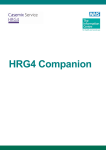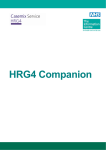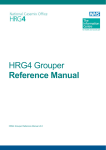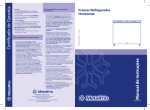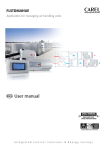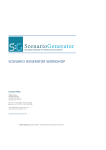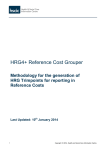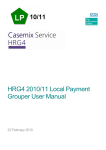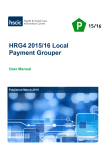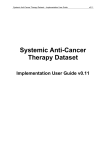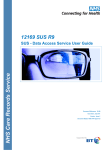Download HRG4 Companion - Health & Social Care Information Centre
Transcript
HRG4 Companion The Health and Social Care Information Centre is England’s central, authoritative source of health and social care information The National Casemix Office designs and refines classifications that are used by the NHS in England to describe healthcare activity Health and Social Care Information Centre www.ic.nhs.uk 0845 300 6016 [email protected] National Casemix Office www.ic.nhs.uk/casemix Glossary of Terms www.ic.nhs.uk/jargon-buster Department of Health - Payment by Results www.dh.gov.uk/pbr NHS Connecting for Health www.cfh.nhs.uk Contents 1 Introduction Casemix Healthcare Resource Groups (HRGs) HRG4 The HRG4 Grouper 2 HRG4 Design Concepts The Casemix Design Framework HRG4 Code Structure Setting Independence HRGs for Non-Admitted Consultations 3 HRG4 Grouping Logic Procedure Hierarchies Diagnosis Hierarchies Complication and Comorbidity (CC) Splits Multi-episode Spells Multiple trauma Accommodating Multiple Procedures Unbundling 4 4 4 4 4 5 5 5 5 6 7 7 7 8 8 8 8 10 4 Stakeholder Engagement 11 5 Further Information 12 HRG4 Casemix Design Framework 12 HRG4 Companion v3 1 Introduction Casemix Casemix is a method of classifying patient care based on the expected resource used in the provision of care. Healthcare Resource Groups (HRGs) are the main casemix classification within the NHS in England and are developed and maintained by the National Casemix Office within the Health and Social Care Information Centre. Healthcare Resource Groups (HRGs) HRGs are clinically meaningful groupings of patient activity derived from NHS patient records using procedure and diagnosis codes. They are used as a means of determining fair and equitable reimbursement for healthcare services as they provide consistent 'units of currency' to support standardised commissioning across the NHS. HRGs can also help organisations to better understand their activity, the different types of patients they care for, and the treatments they receive. They enable the comparison of activity within and between different organisations and provide an opportunity to benchmark treatments and services and support trend analysis over time. HRG4 HRG4 is a casemix classification which aggregates patient level data into HRGs. It has been developed to support the Department of Health Payment by Results (PbR) national policy by providing a classification that represents current clinical practice. HRG4 also supports service planning, costing and commissioning between PCTs and trusts by providing reliable and consistent activity data to support patient choice and service planning analysis. Its distinguishing attributes are increased scope, settings, granularity and specificity. HRG4 is designed to be optimised for accurate, good quality coding. HRG4 also contains several new design concepts which better differentiate patient activity types. The HRG4 Grouper The HRG4 Grouper is the software application that implements HRG4 design. It performs validation checks, uses a complex algorithm to assign HRGs to patient records and produces output files which contain the original input data with assigned HRGs. It also produces quality files that contain details of any errors or conflicts. For more information about using the grouper application for local grouping, please refer to the HRG4 Grouper Reference Manual. Copyright 2013, Health and Social Care Information Centre. All Rights Reserved. 4 HRG4 Companion v3 2 HRG4 Design Concepts The Casemix Design Framework HRG4 design is governed by the Casemix Design Framework which provides comprehensive guidance for stakeholders involved in the design process with regard to scope, format and data and performance requirements. Stakeholders are comprised of representatives from Royal Colleges, clinical professions, Department of Health Policy and Operations team and other bodies such as NHS CfH, the independent sector and NHS Chief Executives. In brief the design rules stipulate that: • • • Data used to define HRGs should be routinely available There should be a manageable number of HRG groupings to cover all patients HRGs must be clinically meaningful and contain activity with similar resource intensity HRG4 Code Structure HRG4 uses a five character code structure to identify HRGs. Chapter/Subchapter AA • • • • HRG Number NN Split A The first character represents the HRG Chapter (A) The first two characters together represent the HRG Subchapter (AA) The next two numeric characters represent the HRG Number within the chapter (NN) The final character signifies the Split applicable to the episode (A) Chapters/Subchapter HRGs are divided into clinically meaningful sections known as chapters and subchapters. The first character of an HRG code identifies chapter, the second character identifies subchapter and both characters identify the subchapter specifically HRG Number The HRG Number is a two digit numeric code which identifies the HRG within the subchapter. The lower the HRG number, the higher the expected resource use of that HRG in relation to other HRGs within the chapter. Split A split is a single character code in the last position which further describes activity, such as age, length of stay or complications. A value of ‘Z’ indicates that no split is present. The example below shows the code structure for an HRG. In this case the split value of ‘A’ represents an age split. The details of the split are defined in the HRG label. Chapter /Subchapter HRG Number Split LA 03 A HRG Label Kidney Transplant 19 years and over from Live donor Setting Independence HRG4 supports setting independent service delivery meaning that if a procedure or intervention can be performed across different care settings, the same HRG can be derived regardless of setting. For example, an endoscopy would generate the same HRG regardless of whether it was performed as an outpatient, a daycase or an inpatient Copyright 2013, Health and Social Care Information Centre. All Rights Reserved. 5 HRG4 Companion v3 procedure. This rule applies to procedure based HRGs only and does not apply to diagnosis based HRGs. HRGs for Non-Admitted Consultations Non-Admitted Consultation HRGs require that a procedure is recorded where relevant but do not use diagnosis data even if recorded. HRG derivation cannot be dependent on diagnosis as the data is not mandated as part of the outpatient Commissioning Data Set. The underlying procedure required for HRG derivation may not always be recorded for outpatients or ward attenders, and it is also possible that a procedure is not carried out. In these situations HRG4 allows allocation of an HRG where minimum mandatory information is recorded. These are assigned to one of the global Non-Admitted HRGs within Subchapter WF. For further information, please refer to the HRG4 Chapter Summary for WF, Non-Admitted Consultations. Copyright 2013, Health and Social Care Information Centre. All Rights Reserved. 6 HRG4 Companion v3 3 HRG4 Grouping Logic Procedure Hierarchies Procedure Hierarchies provide a comparison mechanism which reflects the relative complexity of procedures across all HRG chapters. Each procedure has been assigned a value which reflects its relative resource use. Values 0, 1 and 2 identify procedures which cannot be used for grouping, 3 and 4 are used for non-admitted consultations and values 5 to 15 provide a scale of relative resource use where 5 represents the least and 15 represents the most resource intensive procedures. Value 0 Description OPCS codes not valid for grouping (such as approach codes and site of operation codes in the primary position) 1 Non-operative procedures with minimal resource (such as fitting a sling or administering an injection) 2 Procedures that will generate unbundled HRG(s) Procedure hierarchies are not used to determine unbundled HRGs so every instance of a procedure generates an unbundled HRG. This hierarchy value used only for completeness 3,4 5-15 Procedures relating to subchapter WF, Non-admitted Consultations Scale of relative resource use. 5 represents least and 15 represents most resource intensive procedures If a single procedure is recorded for a patient and its hierarchy value is equal to or greater than 5, it will be used for grouping. If more than one procedure is recorded the grouper selects the dominant procedure based on the hierarchy value. Where hierarchy values are equal the earliest recorded of the highest ranking procedures is used to drive grouping. In the absence of any procedures, or where the only procedure(s) has a hierarchy value of 1, the grouper will switch to using diagnosis to determine the HRG. Diagnosis Hierarchies Every episode records a primary diagnosis. If a multi-episode spell contains differing primary diagnoses, the primary diagnosis of the spell must be established before the HRG can be determined. Value 0 3-7 Description ICD-10 code not valid for grouping Scale of relative resource use in which 3 represents the lowest and 7 represents the most resource intensive diagnoses Each diagnosis code that is valid in the primary position has a hierarchical value associated with its resource impact based on length of stay analysis. Once the primary diagnosis of the spell has been established it can be used to determine the spell HRG. There are five bands which run from 3 to 7 where 3 represents the lowest and 7 represents the most resource intensive diagnoses. Copyright 2013, Health and Social Care Information Centre. All Rights Reserved. 7 HRG4 Companion v3 Complication and Comorbidity (CC) Splits Complication and comorbidity splits provide a method of incorporating varying levels of severity and complexity within HRG design. HRGs are split using subchapter-specific CC lists which identifies diagnoses that are expected to result in additional resources being used and ‘split’ HRGs accordingly. A particular diagnosis may be a major complication for some procedures whilst not being a relevant complication for others. The relevance and ranking of complications and comorbidities are regularly assessed at subchapter level by individual Expert Working Groups (EWGs) to ensure they remain clinically accurate and appropriately ranked. CC splits and Non-Admitted Consultation treatments Diagnosis is not a mandatory item in the Outpatient Commissioning Data Set. The grouping process does not, therefore, use diagnosis for Non-Admitted Consultation treatments and so cannot apply CC splits. Multi-episode Spells In a multi-episode spell, all diagnoses are evaluated as potential complications and comorbidities, with the exception of the primary diagnosis for the episode containing the dominant procedure. Any diagnosis within a spell, other than the spell primary diagnosis, is regarded as a secondary diagnosis for the purposes of CC reference, with the exception of duplicate diagnoses within a spell and four-digit ICD-10 codes that end in .9 where the same three-digit ICD-10 code has been determined as the primary diagnosis of the spell. Multiple trauma A mechanism has been developed to identify high resource, complex diagnoses and treatments associated with multiple trauma cases. For example, significant simultaneous traumatic injuries involving more than one body area. Traumatic single injuries are addressed elsewhere within the relevant chapters. For further information, please refer to the HRG4 Chapter Summary for VA, Multiple Trauma. Accommodating Multiple Procedures In the majority of cases the dominant procedure, as determined by the procedure hierarchy, is used to derive the HRG. However certain subchapters contain specific multiple procedure logic, designed to determine the derived HRG using more than one procedure. Multiple Procedure Logic Where there are a relatively small number of procedures that can be performed in combination with one another, flags may be used to derive the HRG, dependant on what other procedures are recorded with the dominant procedure. For example: If P23.2 Anterior colporrhaphy NEC is recorded with no other procedures present, and no secondary diagnoses are recorded, then HRG MA04B Lower Genital Tract Intermediate Procedures without CC will be generated. If M53.3 Introduction of tension-free vaginal tape is recorded with no other procedures present, then HRG LB51Z Vaginal Tape Operations for Urinary Incontinence will be generated. However, if these procedures are both performed and recorded and either is the dominant procedure, with no secondary diagnoses then the HRG generated will be MA03B Lower Genital Tract Major Procedures without CC. Copyright 2013, Health and Social Care Information Centre. All Rights Reserved. 8 HRG4 Companion v3 Both procedures have an associated flag attached which requires the grouper to reference a list containing the other procedure. Where both procedures are identified within the record an HRG is generated which considers both significant procedures. Escalator Logic Escalator logic can drive grouping to a higher HRG to reflect additional complexity. If a procedure is performed in conjunction with another procedure from a specified list, an HRG will be derived representing higher resource use than for either procedure on its own. For example: If W47.1, Primary prosthetic replacement of head of femur not using cement is recorded as the dominant procedure with no other procedures present, and no secondary diagnoses recorded, then HRG HA12 Major Hip Procedures category 1 for Trauma without CC will be assigned, where the Trauma and Malignancy primary diagnosis criteria are fulfilled. However, if a procedure from any other HA or HB ‘Intermediate’ Category HRG is also recorded such as W04.2 Triple fusion of joints of hindfoot (which as a dominant procedure would map to HRG roots HA31, Major Foot Procedures for Trauma or HB32, Intermediate Foot Procedures for Non-Trauma category 2, dependent on whether the Trauma and Malignancy primary diagnosis criteria are fulfilled,) then this is escalated to the ‘Major’ category HRG, in this either HRG root HR06, Reconstruction Procedures Category 1, where the Trauma and Malignancy primary diagnosis criteria are fulfilled,, or HB31Z Major Foot Procedures for Non-Trauma. If W04.2 - Triple fusion of joints of hindfoot is recorded as the dominant procedure with no other procedures present, and no secondary diagnoses recorded, then HRG root HA31 -Major Foot Procedures for Trauma or HB32 - Intermediate Foot Procedures for Non-Trauma category 2 will be assigned, dependent on whether the Trauma and Malignancy primary diagnosis criteria are fulfilled. However, if in addition to W04.2 - Triple fusion of joints of hindfoot an additional procedure is recorded, such as W47.1 - Primary prosthetic replacement of head of femur not using cement, then despite W04.2 remaining the dominant procedure the HRG root is escalated to a higher category of HRG. In this case, if the HRG root produced was HA31 (i.e. the trauma and malignancy criteria were fulfilled) then it would escalate to HR06 - Reconstruction Procedures Category 1 , or if the HRG root was HB32 (i.e. the trauma and malignancy criteria were not fulfilled) then it would escalate to HB31 - Major Foot Procedures for Non-Trauma. Summation Logic In Subchapter BZ, secondary procedures have a modifying effect on HRG assignment. All Vitreous Retina (VR) procedures have been assigned to a VR band from 1 to 5 depending on their relative complexity. The higher the VR band the higher the complexity. The Vitreous Retina HRGs are assigned based on the sum of the bands of all VR procedures present within a record. Copyright 2013, Health and Social Care Information Centre. All Rights Reserved. 9 HRG4 Companion v3 Sum of VR Bands HRG 0, 1 or 2 3, 4 or 5 6, 7, 8, 9 or 10 11 or over BZ23Z BZ22Z BZ21Z BZ20Z Vitreous Retinal Procedures - category 1 Vitreous Retinal Procedures - category 2 Vitreous Retinal Procedures - category 3 Vitreous Retinal Procedures - category 4 For example, C79.1 Vitrectomy using anterior approach + C83.1 Pigment epithelium translocation of retina. These procedures have VR bands of 3 and 4 making a total of 7, so the HRG derived would be BZ21Z Vitreous Retinal Procedures - category 3. Please note that the multiple procedure logic examples provided in section 3.7 are valid for the HRG4 2013/14 Local Payment Grouper design and may not be applicable to future Reference Costs Grouper design. Full details are available in the respective Code to Group Workbook files released as part of the standard documentation suite that accompanies each Grouper release. For further details and worked examples of specific multiple procedure logic, please refer to the HRG4 Chapter Summaries. Unbundling Unbundling is the first step in the grouping process, following data validation. Unbundled procedures are processed separately to derive unbundled HRGs. The grouper then ignores these unbundled components when deriving the core HRG for an episode or spell. When all significant procedures in an admitted patient care episode or spell are unbundled, diagnosis is used to derive a core HRG for the episode. For non-admitted care, if all procedures are unbundled the episode is allocated one of the eight relevant non-admitted care attendance HRGs as a core HRG. Unbundled HRGs have been developed for following service areas: • Chemotherapy – procurement and delivery • Radiotherapy – planning and delivery • Diagnostic Imaging • Rehabilitation • Critical Care • Specialist Palliative Care • High Cost Drugs Unbundled HRGs provide the following benefits: • Better representation of activity and cost • Support for service redesign • Support for Patient Choice. Some significant elements of cost and activity can be ‘unbundled’ from core HRGs. The impact of unbundling is that a record will be assigned more than one HRG if it includes any unbundled elements. The ‘Unbundled components’ become an HRG in their own right as additions to a core HRG. For example, a record may be assigned the following HRGs depending on the elements of care recorded within it: Core HRG + Unbundled Chemotherapy HRGs + Unbundled High Cost Drug HRGs + Unbundled Diagnostic Imaging HRGs + Unbundled Rehabilitation HRGs Copyright 2013, Health and Social Care Information Centre. All Rights Reserved. 10 HRG4 Companion v3 4 Stakeholder Engagement It is recognised that one of the major strengths of HRG4 is the level of clinical input and HRG4 development remains committed to an iterative process of stakeholder consultation. Each subchapter has at least one EWG advising on HRG definitions. Expert Reference Panels and Steering Groups provide cross-chapter interface in areas such as rehabilitation and high cost drugs. These groups provide invaluable medical, financial and allied health professional guidance. HRG4 is updated on an annual basis to ensure clinical relevance and design accuracy. The key role played by EWGs and other advisory bodies continues through on-going maintenance and enhancement by reviewing and where necessary revising design parameters and assessing the performance of HRGs. The National Casemix Office gratefully acknowledges the support of the following organisations whose representation through EWGs is central to clinical accuracy and ensuring reflection of working practice. • • • • • • • • • • • • • • • • • • • • • • • • • • • • • • • • Association of British Neurologists Society of British Neurological Surgeons Royal College of Anaesthetists British Pain Society Royal College of Ophthalmologists British Association of Otorhinolaryngologists, Head and Neck Surgeons Faculty of Dental Surgery British Thoracic Society Society of Cardiothoracic Surgeons British Cardiac Society Royal College of Surgeons British Society of Gastroenterology British Association of Rheumatology British Geriatrics Society British Orthopaedic Association British Association of Surgical Oncologists British Burns Association British Association of Plastic Surgeons British Association of Dermatologists Association of Genito-urinary Medicine British Diabetic Association British Association of Urological Surgeons Renal Association Royal College of Obstetricians and Gynaecologists Royal College of Paediatrics and Child Health British Association of Perinatal Medicine Vascular Society Royal College of Radiologists British Nuclear Medicine Society British Society of Haematologists Faculty of Clinical Oncology Joint Collegiate Committee of Oncology Copyright 2013, Health and Social Care Information Centre. All Rights Reserved. 11 HRG4 Companion v3 5 Further Information Health and Social Care Information Centre Helpdesk: Email: www.ic.nhs.uk 0845 300 6016 [email protected] The HSCIC is England's central, authoritative source of health and social care information for frontline decision makers. NHS Connecting for Health www.cfh.nhs.uk NHS CfH’s role is to maintain and develop the NHS national IT infrastructure. This infrastructure includes a number of national services and a range of national applications. OPCS: www.cfh.nhs.uk/opcs The clinical classification OPCS-4 is mandatory for Admitted Patient Care Commissioning Data Sets (CDS) and wherever there is a national requirement to support secondary uses. The classification may also be used locally for operational uses. World Health Organisation www.who.int The WHO is the directing and coordinating authority for health within the United Nations system. It is responsible for providing leadership on global health matters, shaping the health research agenda, setting norms and standards, articulating evidence-based policy options, providing technical support to countries and monitoring and assessing health trends. ICD-10 www.who.int/classifications/icd The International Classification of Diseases (ICD) is the standard diagnostic tool for epidemiology, health management and clinical purposes, including analysis of the general health of population groups and monitoring diseases and other health problems. Department of Health (Payment by Results) www.dh.gov.uk/pbr PbR is the transparent rules-based payment system in England under which commissioners pay healthcare providers for each patient seen or treated, taking into account the complexity of the patient’s healthcare needs. PbR promotes efficiency, supports patient choice and increasingly incentivises best practice models of care. HRG4 Casemix Design Framework The Casemix Design Framework is maintained by the Design Authority for Casemix, who provide a strategic steer for all stakeholder groups with regard to maintaining consistency of design intent and methodology across current HRG chapters. Copyright 2013, Health and Social Care Information Centre. All Rights Reserved. 12 HRG4 Companion v3 The HRG4 Documentation Suite The HRG4 Documentation Suite is a comprehensive resource of supporting materials, designed to assist users in understanding the design concepts, logic and practical use of the HRG4 Grouper. Below is a list of the various HRG4 documents which are available to download from the National Casemix Office website www.ic.nhs.uk/casemix HRG4 Companion is a starting point and general reference for new and existing users, providing an introduction to HRGs, groupers, HRG4 design concepts and grouping logic and useful links to further information. Casemix Design Framework defines the rules and criteria followed when designing Casemix classification systems. HRG4 Grouper Reference Manual provides full instructions on how to prepare and group data using the HRG4 Grouper software application. HRG4 Summary of Changes provides an overview of the main changes between the current HRG4 grouper design and its predecessor. HRG4 Roots workbook identifies new HRGs, deleted HRGs and changes to existing HRG Labels between designs using colour-coding. HRG4 Chapter Summaries provide an overview of the scope, composition and grouping logic of individual subchapters along with illustrative worked examples. They also include updates on the changes within subchapters. HRG4 Code to Group workbook provides details on all mappings between primary classification codes and HRGs. Also detailed within the workbook are the logic conditions required to generate the HRGs. HRG4 Code to Group User Manual serves as an introduction to using the Code to Group workbook to perform manual grouping. It also details some basic design concepts and provides worked examples of a variety of different grouping scenarios. HRG4 Chapter Listings provide details, listed by HRG, of the codes that can map to those groups, along with details of flags, lists and complications and comorbidities Copyright 2013, Health and Social Care Information Centre. All Rights Reserved. 13














